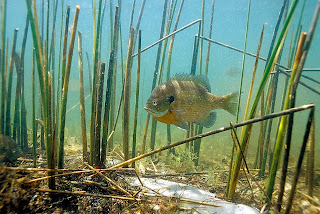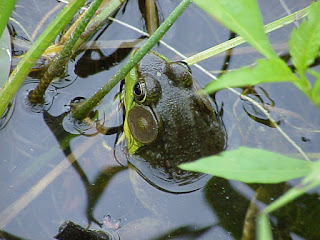
Finding Value in Our Healthy Shallow Lakes
By Bill Bartodziej, Natural Resources Specialist
 |
| Going up to “the lake” is a Minnesota tradition. |
Lakes up north
It’s a flawless summer morning – light breeze, sun is rising, and the temperature is a perfect 70 degrees. We pack the SUV full of floaties, sun screen, fishing rods and swim suits. We program our favorite music playlist for the road trip and then set course for “up north”. Getting away from the city bustle and spending a few weekends on north-country lakes is a tradition that’s in our blood; it’s just the Minnesota way.
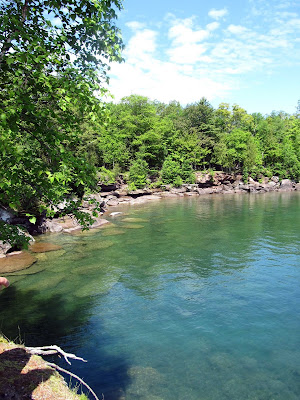 |
|
Lake Superior
Photo credit: Rosanna Imholte
|
So what do you think makes the ideal lake? Some descriptors that are often associated with high quality lakes are: clean, clear, weed-free, deep, good fishing, sandy beaches, blue water, panoramic views and secluded. Not that we ever brag, but Minnesota does have the most lakes (11,842, actually) in the contiguous United States. Lakes vary quite a bit, depending on where they are located in the state and how deep they get.
Generally, the lakes that we have up north are quite different from the lakes that we find in the Twin Cities area. This mainly has to do with geology and watershed type. Northern lakes are often formed by depressions in granite bedrock, with their watersheds being dominated by forest cover. This combination usually harbors lakes that are low in nutrients, clear and deep, with minimal aquatic plant growth.
 |
| Casey Lake in a clear-water state |
Urban lakes
In our urban watershed, we have a mix of relatively deep and shallow lakes. Rich soils and storm water runoff contribute to our local lakes being higher in nutrients compared to the lakes that we visit up north. Our local lakes are generally more “productive”, meaning that they support more plant growth. Free floating algae, cattail, lily and submersed rooted species take advantage of the nutrients in our urban lakes and become well established.
 |
| Casey Lake in murky-water, algae-dominated state |
Usually, shallow lakes (less than twelve feet) are found in one of two completely different states: a murky-water, algae dominated state (poor quality) and a clear-water, plant dominated state (healthy or high quality). It is uncommon to find shallow lakes that are in the middle, with moderate algae and rooted aquatic plant growth, for a long period of time – say several years. Watershed management works to reduce nutrient inputs to our lakes and to improve water quality.
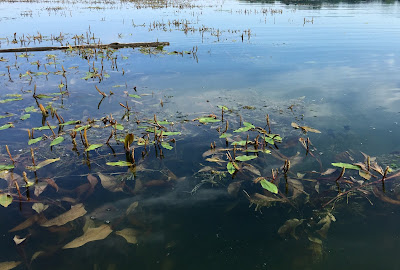 |
| Native aquatic plants growing in a clear lake. |
Shallow lakes with good water quality support lush rooted aquatic plant growth. This is natural, healthy and a normal condition for shallow lakes. But, this concept is not all that intuitive. Shallow lakes are often misunderstood. Abundant plant growth tends to work against the thought of what an “ideal” or high quality lake is all about.
Our vision of clear, deep northern Minnesota lakes can distort our expectations for our urban lakes. This is especially true with shallow lakes and ponds in our urban watershed. Some use northern Minnesota lakes as a gauge to define how a healthy shallow lake should behave. But not all lakes are created equal, and making direct comparisons between deep and shallow lakes is not advised. This would be analogous to a doctor using a health chart of a six foot male to assess the condition of a five foot female. This examination would obviously be flawed and lead to misdiagnosis.
What we value
In many cultures and places around the world, the clear-water, plant dominated state of shallow lakes is widely accepted and highly desirable. For instance, in Europe and Japan, turbid lakes are turned to clear-water, plant dominated lakes, and this is considered very successful lake management. From a conservation standpoint, their citizens would be upset by the thought of doing anything to impede aquatic plant growth in these lake systems.* But for some reason, our Minnesota cultural heritage seemed to generally miss the important lesson that “healthy shallow lakes grow a lot of plants”. Good water quality promotes a robust aquatic plant community.
So what makes aquatic plants so important in shallow lake systems? A majority of the healthy shallow lakes in our watershed support over ten native submersed plant species. This plant community can be thought of as the underwater forests of our lake systems. Aquatic plants provide food and shelter for wide variety of aquatic insects. This underwater cover creates excellent game fish habitat for species such as largemouth bass, bluegill and northern pike. Rooted plants hold lake-bottom soils in place which limits “turbidity” or particles being suspended in the water column. Aquatic plants also provide a surface or substrate for algae to grow. These algae take nutrients from the water and can lower the nutrients that are available to free-floating algae. This competition for nutrients lowers the risk of substantial algal blooms, especially in the hot summer months. This relationship helps to perpetuate the clear-water state in shallow lakes.
Watershed management and shallow lakes
Our Watershed District implements intensive lake and watershed management projects to reduce nutrient inputs to our lakes. Our activities are directed by federal and state water quality laws. Over the last few years, through this work, two shallow lakes in our watershed, Kohlman and Casey Lakes, have seen dramatic improvements in water quality. These lakes are now in a clear-water state. The changes that have occurred have brought about many discussions with citizens concerning lake use, aesthetics and the value of aquatic plants. The conflict really boils down to how shoreland owners use and view the lake. From water quality and biological diversity standpoints, watershed management is a huge success, but from a recreational use standpoint, management has failed.
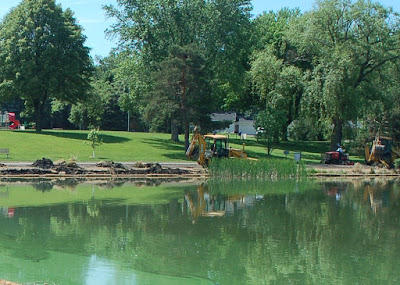 |
| Casey Lake before the shoreline restoration and carp removal was complete. |
Most often, people that move around on the water with speed would like healthy shallow lakes to act like deep lakes. This means clear water and very limited plant growth in the center of the lakes. However, a shallow lake with clear water will support lush rooted plant growth throughout the entire lake. The extent of the plant growth is really the crux of the problem. Surfaced plants do not mix well with water skiing and pleasure boating. Deep water lakes have large expanses of open-water throughout summer, but healthy urban shallow lakes often do not. In addition, many shoreland owners view surfaced aquatic plants as “weedy” and “unsightly”.
Sharing information
Maybe in a perfect world, with knowledge and exposure to a different point of view, affected lake users would quickly embrace the idea that abundant plant growth is an essential component in healthy shallow lakes. They would realize that this response is the direct result of improved lake water quality, which substantially benefits our watershed community as a whole. However, in reality, it will take time to share knowledge and educate residents on healthy shallow lakes and how they differ from our deep lakes. Maybe, over a period of years, we will see the intrinsic value of healthy shallow lakes go up.
This summer, to begin to address this important educational need, watershed staff and our Citizen Advisory Commission will be working on the production of a shallow lakes educational video. We are happy to have videographer Ben Hansen lead our team on this effort. You may remember the video Ben helped us produce about six years ago about the common carp in the Phalen Chain. It was a great educational tool that highlighted cutting-edge research and management. It can be found at this this LINK.
There really isn’t a video about shallow lakes like this available locally or nationally, so we see this benefiting our watershed, and potentially having impact on a regional and maybe even a national level. We will be shooting video on Kohlman, Casey, Bennett and possibly other shallow lakes in our watershed. We hope to incorporate some aerial and underwater footage in order to make this video product unique and inspiring.
You can help!
If you run across something interesting on a local shallow lake this summer, please let us know! We may be able to get a camera out quickly to film some footage. The plan is to have the shallow lakes video available on You Tube and shorter clips showing up on Instagram and Facebook. Please stay tuned and be on the lookout for a cool video highlighting your healthy shallow lakes this fall.
*Citation: Cooke, D.G., P. Lombardo, and C. Brant. 2001. Shallow and Deep Lakes: Determining Successful Management Options. Lakeline (North American Lake Management Society) 21: 42–46.
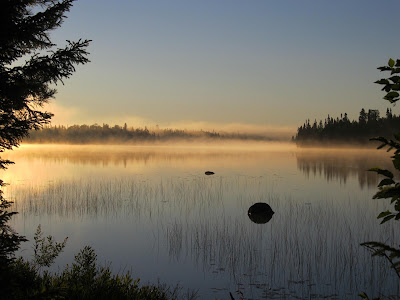 |
| Boundary Waters Canoe Area sunset. Photo credit: Rosanna Imholte |
